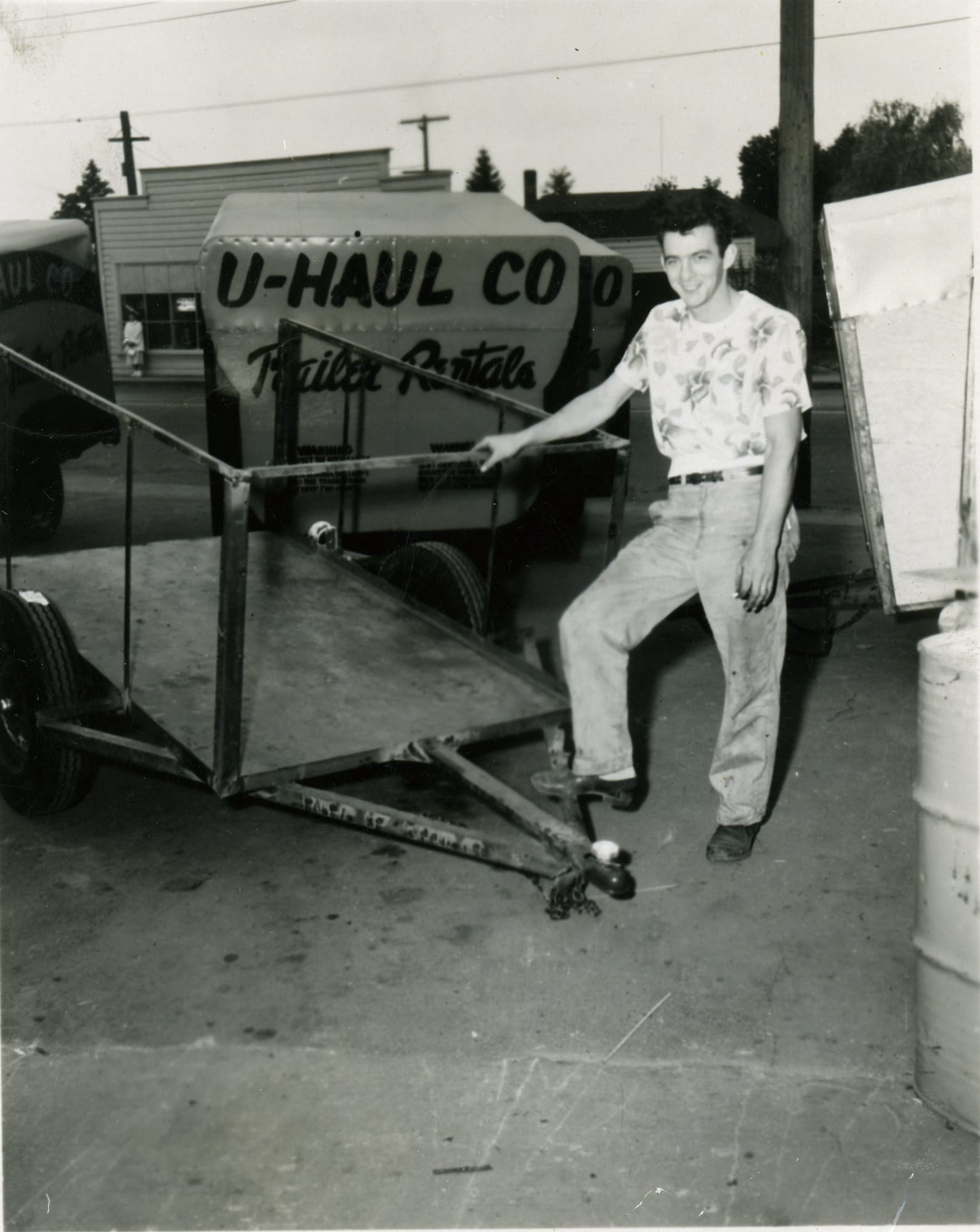RIDGEFIELD — L.S. “Sam” Shoen and wife Anna Mary Carty Shoen left Los Angeles in 1945 after he got out of the Navy.
They packed everything they could fit into their 1937 Ford and, with their 3-month-old son, drove north to Portland.
Their conversations during that trip sparked a billion-dollar business empire, and the place where Anna Mary grew up — the Carty ranch in Ridgefield — became the birthplace of U-Haul.
Those corporate roots were celebrated a few days ago when several generations of company leadership observed U-Haul’s 70th anniversary in conjunction with Ridgefield’s Heritage Days.
The Sept. 12 celebration included the unveiling of a new “Welcome to Ridgefield” sign that notes the city’s role in U-Haul history.
William “Hap” Carty was among the special guests who have been part of the company for 50 years or more. Anna Mary’s brother helped build some of U-Haul’s first trailers on the family ranch. Hap went on to become president of U-Haul International.
The anniversary event gave the company pioneers the chance to recall some defining moments for U-Haul, which now is based in Phoenix.
It started with the Shoens’ road trip in 1945.
“Nobody rented trailers. They had to sell most of their goods and take what they could fit in the car,” Henry Kelly, vice president of industrial relations, told the crowd in the Ridgefield Community Center. “That’s when they developed the idea of U-Haul.”
There were some major start-up hurdles, including the trailers themselves. The first versions were built by a welding shop that converted the rear ends of junker cars into trailers. They were terrible.
Members of the U-Haul team realized that they had to build their own trailers. Their first manufacturing center was the Carty ranch. To cut expenses, Sam and Anna Marie even moved in with her folks on the ranch, which now is part of the Ridgefield National Wildlife Refuge. (The wildlife refuge’s Carty Unit was named for the pioneering family.)
Wood-sided trailers
A battered wood-sided two-wheel trailer from that fledgling fleet was on display Sept. 12 in Davis Park, next to more modern equipment painted in U-Haul’s signature orange and white. Hap Carty had welded his name onto a piece of steel on the old trailer, along with the year it was built: 1946. Those wooden side boards had a Carty connection as well. The lumber came from trees that had been felled on the ranch.
By the end of 1945, about 30 open trailers were on service station lots in Vancouver, Portland and Seattle. The concept of a one-way trailer rental for longer hauls was another challenge. That’s where early U-Haul trailer renters played a dual role. After arriving at their destinations, some of those customers were able to recruit service stations that agreed to become U-Haul dealers.
Before long, Hap Carty said during the presentation, a family could move “from Portland, Ore., to Portland, Maine — and get there economically.”
As the rental network spread, Sam Shoen did the field work. Anna Mary handled the business side, and dealers wrote their checks to “A.M. Shoen,” said Kelly, who’s been with U-Haul for almost 60 years. If those dealers had any gripes, they would share their complaints with Sam when he came by. His response? “I do what the boss tells me.”
Kelly was part of another milestone when U-Haul started renting trucks.
“I was fortunate to build the first one in 1959, off a Dodge chassis,” Kelly said.
Back then, fellow U-Haul pioneer Ron Frank’s job included boosting the company’s visibility. He gave away U-Haul clocks to any business that would take one, including florists and bait shops.
Frank, now executive vice president, got into more substantial transactions when U-Haul had to respond to an economic disaster in the 1970s.
“The oil embargo of 1973 devastated U-Haul,” Frank said. “Oil companies closed tens of thousands of service stations,” and gas stations were the basis of U-Haul’s rental network. So the company started opening its own sites. They bought a closed Gulf station in 1974 and converted it into a U-Haul moving center.
“In Montreal, we bought a Humpty Dumpty potato chip factory,” Frank added.
That format helped the company rebound.
“About 25,000 people work for U-Haul around the country in 1,600 centers owned by U-Haul,” Kelly said. However, the backbone still is the network of rental dealers, Kelly said: about 18,200 of them that have a main business and rent U-Haul trailers as a sideline.
U-Haul also become a big player in the self-storage industry, with about 500,000 storage spaces, Kelly said.
Family transitions
The family that created U-Haul has had some notable transitions as well. The original husband-and-wife partnership ended in 1957 when Anna Mary died; Sam remarried four times and had 13 children.
Sam Shoen died in 1999 in Las Vegas at age 83 after driving his car into a power pole. According to The Columbian’s coverage, Shoen’s death was ruled a suicide.
His death followed years of family turmoil. Several of Shoen’s children had been engaged in a long-running battle for control of the business empire, according to stories following his death. He was forced into retirement by two of his sons, sparking a bitter feud and multimillion-dollar court battle.
U-Haul remains family held, company spokesman Sebastien Reyes said, with the Shoens controlling 55 percent of the business.
“The family operation continues,” said Reyes. “It can take the long-term view, while many other companies manage on a quarter-to-quarter basis.”
“Other national companies are much bigger,” noted Ron Frank, one of the U-Haul pioneers at the Sept. 12 event. “But they achieved their growth through franchising,” he said, while U-Haul became the industrial leader through unity of direction. “And we still have unity of direction.”




